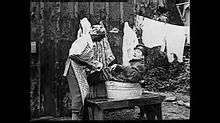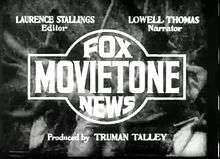Fox Film
The Fox Film Corporation was an American company that produced motion pictures, formed by William Fox on 1 February 1915. It was the corporate successor to his earlier Greater New York Film Rental Company and Box Office Attractions Film Company.
The company's first film studios were set up in Fort Lee, New Jersey but in 1917, William Fox sent Sol M. Wurtzel to Hollywood, California to oversee the studio's new West Coast production facilities where a more hospitable and cost effective climate existed for filmmaking. On July 23, 1926, the company bought the patents of the Movietone sound system for recording sound on to film.
After the Crash of 1929, William Fox lost control of the company in 1930, during a hostile takeover. Under new president Sidney Kent, the new owners merged the company with Twentieth Century Pictures to form 20th Century Fox in 1935.
History
Background
William Fox entered the film industry in 1904 when he purchased a one-third share of a Brooklyn nickelodeon for $1,667.[lower-alpha 1][1] He reinvested his profits from that initial location, expanding to fifteen similar venues in the city, and purchasing prints from the major studios of the time: Biograph, Essanay, Kalem, Lubin, Pathé, Selig, and Vitagraph.[2] After experiencing further success presenting live vaudeville routines along with motion pictures, he expanded into larger venues beginning with his purchase of the disused Gaiety theater,[lower-alpha 2] and continuing with acquisitions throughout New York City and New Jersey, including the Academy of Music.[3]
Fox invested further in the film industry by founding the Greater New York Film Rental Company as a film distributor.[4] However, the major film studios formed the Motion Picture Patents Company in 1908 and the General Film Company in 1910, in an effort to create a monopoly on the creation and distribution of motion pictures. Fox refused to sell out to the monopoly, and sued under the Sherman Antitrust Act, eventually receiving a $370,000[lower-alpha 3] settlement, and ending restrictions on the length of films and the prices that could be paid for screenplays.[4]
In 1914, reflecting the broader scope of his business, he renamed it the Box Office Attraction Film Rental Company.[5] He entered into a contract with the Balboa Amusement Producing Company film studio, purchasing all of their films for showing in his New York area theaters and renting the prints to other exhibitors nationwide.[6] He also continued to distribute material from other sources, such as Winsor McCay's early animated film Gertie the Dinosaur.[7][8] Later that year, Fox concluded that depending on other companies for the products he depended on was insufficient. He purchased the Éclair studio facilities in Fort Lee, New Jersey, along with property in Staten Island,[9][10] and arranged for actors and crew. The company became a film studio, with its name shortened to the Box Office Attractions Company; its first release was Life's Shop Window.[11]
Fox Film Corporation

Always more of an entrepreneur than a showman, Fox concentrated on acquiring and building theaters; pictures were secondary. The company's first film studios were set up in Fort Lee, New Jersey where it and many other early film studios in America's first motion picture industry were based at the beginning of the 20th century.[12][13][14] In 1917, William Fox sent Sol M. Wurtzel to Hollywood to oversee the studio's West Coast production facilities where a more hospitable and cost-effective climate existed for filmmaking. Fox had purchased the Edendale studio of the failing Selig Polyscope Company, that had been making films in Los Angeles since 1909 and was the first motion picture studio in Los Angeles.
With the introduction of sound technology, Fox moved to acquire the rights to a sound-on-film process. In the years 1925–26, Fox purchased the rights to the work of Freeman Harrison Owens, the U.S. rights to the Tri-Ergon system invented by three German inventors, and the work of Theodore Case. This resulted in the Movietone sound system later known as "Fox Movietone" developed at the Movietone Studio. Later that year, the company began offering films with a music-and-effects track, and the following year Fox began the weekly Fox Movietone News feature, that ran until 1963. The growing company needed space, and in 1926 Fox acquired 300 acres (1.2 km2) in the open country west of Beverly Hills and built "Movietone City", the best-equipped studio of its time.
Decline
When rival Marcus Loew died in 1927, Fox offered to buy the Loew family's holdings. Loew's Inc. controlled more than 200 theaters, as well as the MGM studio. When the family agreed to the sale, the merger of Fox and Loew's Inc. was announced in 1929. But MGM studio boss Louis B. Mayer was not included in the deal and fought back. Using political connections, Mayer called on the Justice Department's antitrust unit to delay giving final approval to the merger. Fox was badly injured in a car crash in the summer of 1929, and by the time he recovered he had lost most of his fortune in the fall 1929 stock market crash, ending any chance of the merger going through even without the Justice Department's objections.
Overextended and close to bankruptcy, Fox was stripped of his empire in 1930 and ended up in jail. Fox Film, with more than 500 theatres, was placed in receivership. A bank-mandated reorganization propped the company up for a time, but it soon became apparent that despite its size, Fox could not stand on its own.
Merger
Under new president Sidney Kent, the new owners began negotiating with the upstart, but powerful independent Twentieth Century Pictures in the early spring of 1935. The two companies merged that spring as 20th Century-Fox (the hyphen was dropped in the 1980s). For many years, 20th Century Fox claimed to have been founded in 1915. For instance, it marked 1945 as its 30th anniversary. However, in recent years it has claimed the 1935 merger as its founding, even though most film historians agree it was founded in 1915.[15]
Products
Feature films
A 1937 fire in a Fox film storage facility destroyed over 40,000 reels of negatives and prints, including the best-quality copies of every Fox feature produced prior to 1932;[16] although copies located elsewhere allowed many to survive in some form, over 75% of Fox's feature films from before 1930 are completely lost.[17]
Newsreels

In 1919, Fox began a series of silent newsreels, competing with existing series such as Hearst Metrotone News, International Newsreel, and Pathé News. Fox News premiered on 11 October 1919, with subsequent issues released on the Wednesday and Sunday of each week. Fox News gained an advantage over its more established competitors when President Woodrow Wilson endorsed the newsreel in a letter, in what may have been the first time an American president commented on a film.[18] In subsequent years, Fox News remained one of the major names in the newsreel industry by providing often-exclusive coverage of major international events, including reporting on Pancho Villa, the airship Roma, the Ku Klux Klan, and a 1922 eruption of Mount Vesuvius.[19] The silent newsreel series continued until 1930.[20]
In 1926, a subsidiary, Fox Movietone Corporation, was created, tasked with producing newsreels using Fox's recently acquired sound-on-film technology. The first of these newsreels debuted on 21 January 1927. Four months later, the 25 May release of a sound recording of Charles Lindbergh's departure on his transatlantic flight was described by film historian Raymond Fielding as the "first sound news film of consequence".[21] Movietone News was launched as a regular newsreel feature 3 December of that year.[22] Production of the series continued after the merger with Twentieth Century Pictures, until 1963, and continued to serve 20th Century Fox after that, as a source for film industry stock footage.[20]
Unlike Fox's early feature films, the Fox News and Fox Movietone News libraries have largely survived. The earlier series and some parts of its sound successor are now held by the University of South Carolina, with the remaining Fox Movietone News still held by the company.[20]
Serials
Fox Film briefly experimented with serial films, releasing the 15-episode Bride 13 and the 20-episode Fantômas in 1920. William Fox was unwilling to compromise on production quality in order to make serials profitable, however, and none were subsequently produced.[23]
Short films
Hundreds of one- and two-reel short films of various types were also produced by Fox. Beginning in 1916,[24] the Sunshine Comedy division created two-reel comedy shorts. Many of these, beginning with 1917's Roaring Lions and Wedding Bliss, starring Lloyd Hamilton, were slapstick, intended to compete with Mack Sennett's popular offerings.[25] Sunshine releases continued until the introduction of sound.[26] Other short film series included Imperial Comedies, Van Bibber Commedies (with Earle Foxe), O'Henry, Married Life of Helen and Warren, and Fox Varieties.[27] Fox's expansion into Spanish-language films in the early 1930s also included shorts.[28]
Notes
- ↑ $44 thousand in 2016 dollars
- ↑ Unrelated to the Broadway theatre operating at the same time, also called the Gaiety
- ↑ $8.87 million in 2016 dollars
References
- ↑ Solomon 2011, pp. 10–11.
- ↑ Solomon 2011, p. 11.
- ↑ Solomon 2011, pp. 11–12.
- 1 2 Solomon 2011, p. 12.
- ↑ Solomon 2011, p. 13.
- ↑ Slide 2001, pp. 26–27.
- ↑ Canemaker 2005, p. 182.
- ↑ Crafton 1993, p. 112.
- ↑ Golden 1996, p. 30.
- ↑ Shepherd 2013, p. 197.
- ↑ Solomon 2011, pp. 14, 227.
- ↑ Koszarski, Richard (2004). Fort Lee: The Film Town. Indiana University Press. ISBN 0-86196-652-X.
- ↑ "Studios and Films". Fort Lee Film Commission. Archived from the original on April 25, 2011. Retrieved May 30, 2011.
- ↑ Fort Lee Film Commission (2006). Fort Lee Birthplace of the Motion Picture Industry. Arcadia Publishing. ISBN 0-7385-4501-5.
- ↑ Is Fox really 75 this year? Somewhere, the fantastic Mr. (William) Fox begs to differ. New York Post, 2010-02-10.
- ↑ Pierce, David. "The Legion of the Condemned — Why American Silent Films Perished". Film History. 9 (1): 5–22.
- ↑ Solomon 2011, p. 1.
- ↑ Fielding 2011, p. 60.
- ↑ Fielding 2011, p. 61.
- 1 2 3 Wilsbacher, Greg. "The Fox Movietone News Donation: A Brief History". Moving Image Research Collections. University of South Carolina. Retrieved 2015-02-06.
- ↑ Fielding 2011, pp. 102–104.
- ↑ Fielding 2011, p. 105.
- ↑ Solomon 2011, p. 57.
- ↑ Solomon 2011, p. 23.
- ↑ Solomon 2011, pp. 30–31.
- ↑ Solomon 2011, pp. 49–50.
- ↑ Solomon 2011, p. 71.
- ↑ Solomon 2011, p. 145.
Bibliography
- Canemaker, John (2005). Winsor McCay: His Life and Art (Revised ed.). Abrams Books. ISBN 978-0-8109-5941-5.
- Crafton, Donald (1993). Before Mickey: The Animated Film 1898–1928. University of Chicago Press. ISBN 978-0-226-11667-9.
- Fielding, Raymond (2011) [1972]. The American Newsreel: A Complete History, 1911–1967 (2nd ed.). McFarland. ISBN 978-0-7864-6610-8.
- Golden, Eve (1996). Vamp: The Rise and Fall of Theda Bara. Vestal Press. ISBN 978-1-879511-32-3.
- Shepherd, David J. (2013). The Bible on Silent Film: Spectacle, Story and Scripture in the Early Cinema. Cambridge University Press. ISBN 978-1-107-04260-5.
- Slide, Anthony (2001). The New Historical Dictionary of the American Film Industry (2nd ed.). Scarecrow Press. ISBN 978-1-57886-015-9.
- Solomon, Aubrey (2011). The Fox Film Corporation, 1915–1935: A History and Filmography. McFarland & Company. ISBN 978-0-7864-6286-5.
External links
| Wikimedia Commons has media related to Fox Film films. |